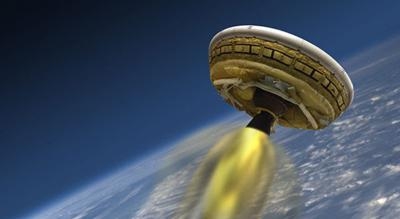Sat, Jun 14, 2014
NASA's 'Flying Saucer' Grounded Because Of Winds Aloft
NASA did not conduct the flight test of the agency's Low-Density Supersonic Decelerator (LDSD) from the U.S. Navy's Pacific Missile Range in Kauai, Hawaii, during its designated launch period. The project's reserved range time at the range will expire Saturday, June 14, with NASA unable to fly the test because of continuing unfavorable weather conditions.

Mark Adler, the Low Density Supersonic Decelerator project manager and Ian Clark, principal investigator on the project, both from NASA's Jet Propulsion Laboratory in Pasadena, California, participated in a media teleconference this morning and addressed questions on the project.
"There were six total opportunities to test the vehicle, and the delay of all six opportunities was caused by weather," said Adler. "We needed the mid-level winds between 15,000 and 60,000 feet to take the balloon away from the island. While there were a few days that were very close, none of the days had the proper wind conditions."
The team had researched for more than two years wind conditions and locations around the world that would be conducive to the test. Kauai was selected because research showed that this area had the proper wind conditions to carry the balloon away from populated areas and where it needed to go over the ocean in order to launch the test vehicle. Recent weather conditions have been unexpected and have caused unacceptable wind conditions to launch the balloon.
NASA continues to look at options for a future launch window. The team is working with the Pacific Missile Range Facility and looking at weather conditions predicted for later in the month when another launch window could be possible.
"Our team has been working on this project for several years, and we have been so focused," said Clark. "We came here to do our job and get this vehicle off the ground, but unfortunately weather didn't allow us to do this. We are very optimistic and are hoping to test the vehicle at the end of the month."
(Image provided by NASA)
More News
DETRESFA (Distress Phrase) The code word used to designate an emergency phase wherein there is reasonable certainty that an aircraft and its occupants are threatened by grave and i>[...]
"General aviation is at the forefront of developing and introducing innovative technologies that will transform the entire aviation industry..." Source: Kyle Martin, Vice President>[...]
Direct Straight line flight between two navigational aids, fixes, points, or any combination thereof. When used by pilots in describing off-airway routes, points defining direct ro>[...]
Aero Linx: Women in Corporate Aviation Women in Corporate Aviation support individuals seeking career advancement and professional development in the business aviation industry. Me>[...]
“We would like to thank the many volunteers that help throughout the year to pull off the event, as well as the several reviewers, judges, and SURVICE staff that provide team>[...]
 ANN's Daily Aero-Term (04.26.24): DETRESFA (Distress Phrase)
ANN's Daily Aero-Term (04.26.24): DETRESFA (Distress Phrase) Aero-News: Quote of the Day (04.26.24)
Aero-News: Quote of the Day (04.26.24) ANN's Daily Aero-Term (04.27.24): Direct
ANN's Daily Aero-Term (04.27.24): Direct ANN's Daily Aero-Linx (04.27.24)
ANN's Daily Aero-Linx (04.27.24) Aero-News: Quote of the Day (04.27.24)
Aero-News: Quote of the Day (04.27.24)



